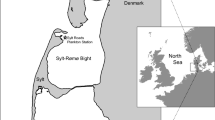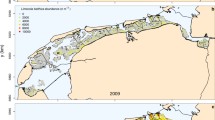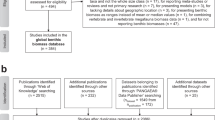Abstract
A method is described by which the pollution status of a marine macrobenthic community may be assessed without reference to a temporal or spatial series of control samples. Theoretical considerations suggest that the distribution of numbers of individuals among species should behave differently from the distribution of biomass among species when influenced by pollution-induced disturbance. Combined k-dominance plots for species biomass and numbers take three possible forms representing unpolluted, moderately polluted and grossly polluted conditions, one curve acting as an “internal control” against which the other can be compared. Field data from unpolluted communities and from a well documented temporal pollution gradient support the model, but further empirical testing is required.
Similar content being viewed by others
Literature cited
Buchanan, J. B. and R. M. Warwick: An estimate of benthic macrofauna production in the offshore mud of the Northumberland coast. J. mar. biol. Ass. U.K. 54, 197–222 (1974)
Connell, J. H.: Diversity in tropical rain forests and coral reefs. Science, N.Y. 199, 1302–1310 (1978)
Gee, J. M., R. M. Warwick, M. Schaanning, J. A. Berge and W. G. Ambrose: Effects of organic enrichment on meiofaunal abundance and community structure in sublittoral soft sediments. J. exp. mar. Biol. Ecol. 91, 247–262 (1985)
Gray, J. S.: Pollution-induced changes in populations. Phil. Trans. R. Soc. (Ser. B) 286, 545–561 (1979)
Gray, J. S.: Detecting pollution induced changes in communities using the log-normal distribution of individuals among species. Mar. Pollut. Bull. 12, 173–176 (1981)
Gray, J. S. and F. B. Mirza: A possible method for detecting pollution induced disturbance on marine benthic communities. Mar. Pollut. Bull. 10, 142–146 (1979)
Hughes, R. G.: A hypothesis concerning the influence of competition and stress on the structure of marine benthic communities. Proc. 19th Eur. mar. Biol. Symp. 391–400 (1985). (Ed. by P. E. Gibbs. Cambridge, England: Cambridge University Press)
Huston, M.: A general hypothesis of species diversity. Am. Nat. 113, 81–101 (1979)
Lambshead, P. J. D. The nematode/copepod ratio. Some anomalous results from the Firth of Clyde. Mar. Pollut. Bull. 15, 256–259 (1984)
Lambshead, P. J. D. and H. M. Platt: Structural patterns of marine benthic assemblages and their relationship with empirical statistical models. Proc. 19th Eur. mar. Biol. Symp. 371–380 (1985). (Ed. by P. E. Gibbs. Cambridge, England: Cambridge University Press)
Lambshead, P. J. D., H. M. Platt and K. M. Shaw: The detection of differences among assemblages of marine benthic species based on an assessment of dominance and diversity. J. nat. Hist. 17, 859–874 (1983)
McIntyre, A. D.: What happened to biological effects monitoring? Mar. Pollut. Bull. 15, 391–392 (1984)
Pearson, T. H.: The effect of industrial effluent from pulp and paper mills on the marine benthic environment. Proc. R. Soc. (Ser. B) 180, 469–485 (1972)
Pearson, T. H.: The benthic ecology of Loch Linnhe and Loch Eil, a sea-loch system on the west coast of Scotland. IV. Changes in the benthic fauna attributable to organic enrichment. J. exp. mar. Biol. Ecol. 20, 1–41 (1975)
Pianka, E. R.: On r- and K-selection. Am. Nat. 104, 592–597 (1970)
Raffaelli, D. G. and C. F. Mason: Pollution monitoring with meiofauna, using the ratio of nematodes to copepods. Mar. Pollut. Bull. 12, 158–163 (1981)
Sanders, H. L.: Marine benthic diversity: a comparative study. Am. Nat. 102, 243–282 (1968)
Warwick, R. M., C. L. George and J. R. Davies: Annual macrofauma production in a Venus community. Estuar. cstl mar. Sci. 7, 215–241 (1978)
Author information
Authors and Affiliations
Additional information
Communicated by J. Mauchline, Oban
Rights and permissions
About this article
Cite this article
Warwick, R.M. A new method for detecting pollution effects on marine macrobenthic communities. Mar. Biol. 92, 557–562 (1986). https://doi.org/10.1007/BF00392515
Accepted:
Issue Date:
DOI: https://doi.org/10.1007/BF00392515




